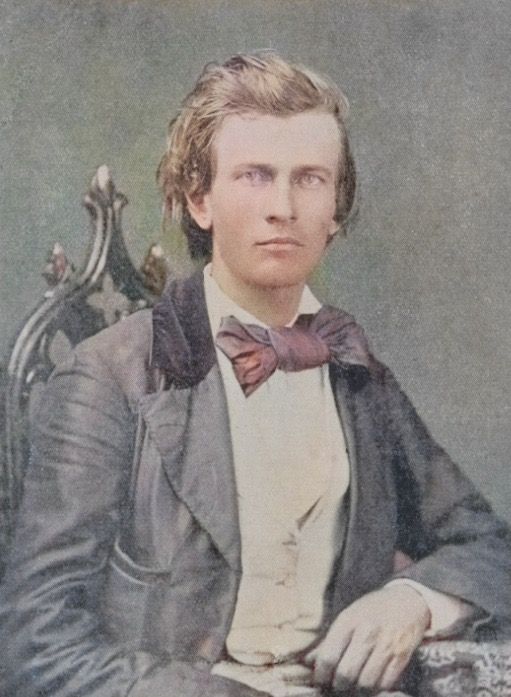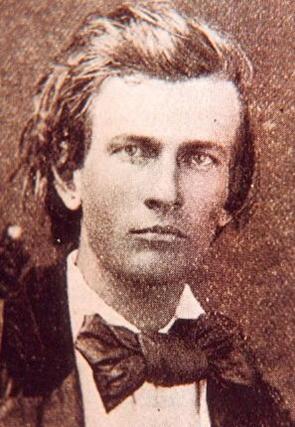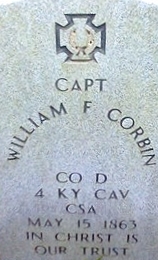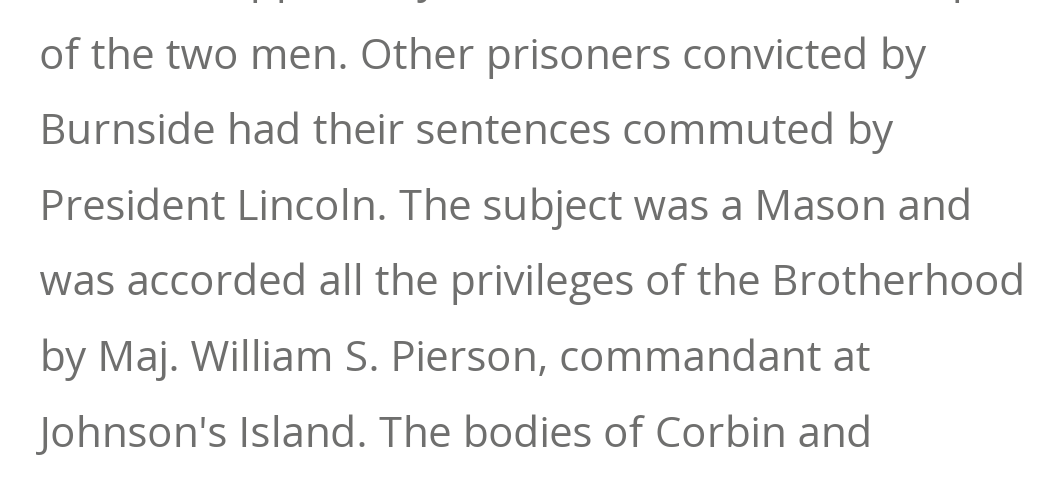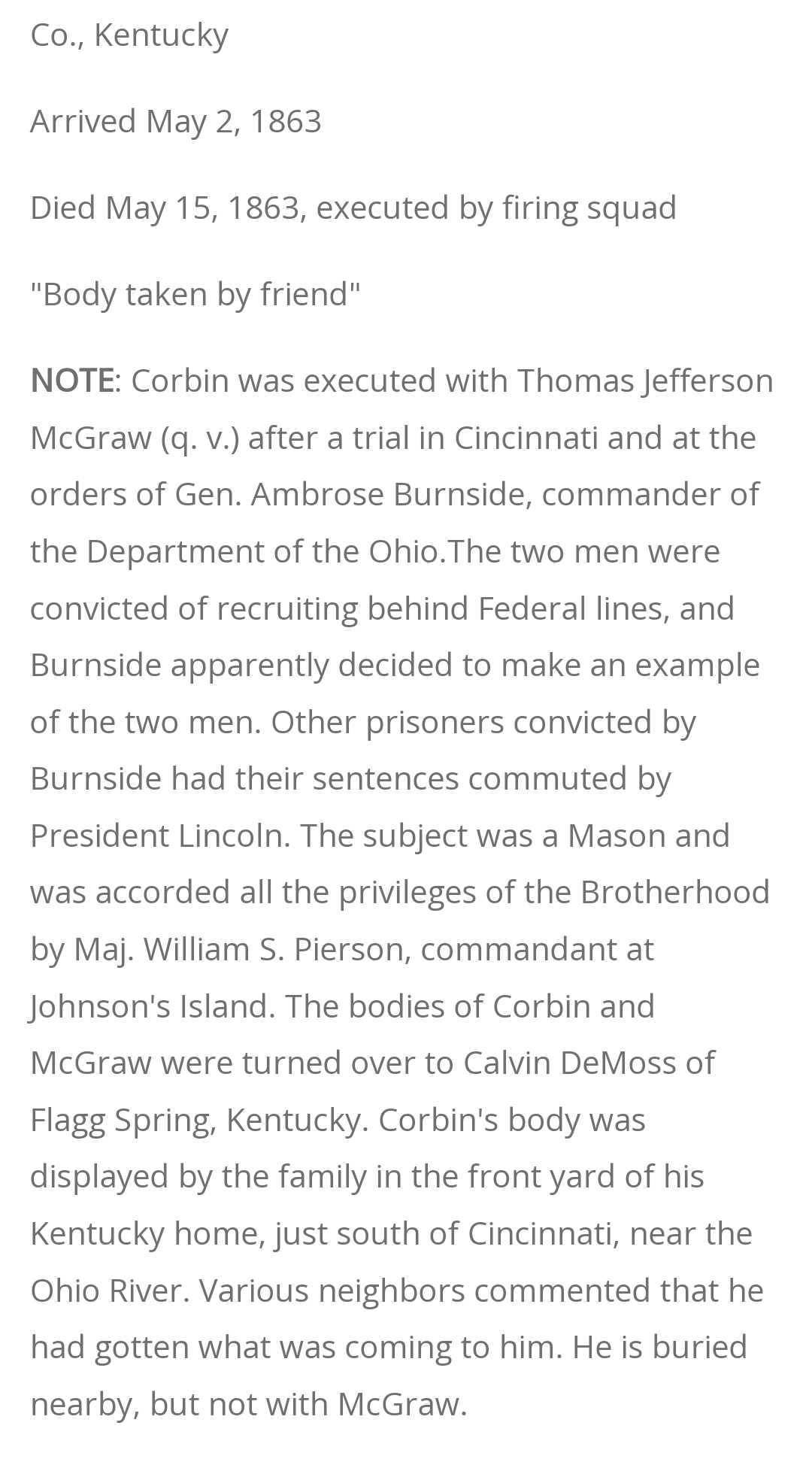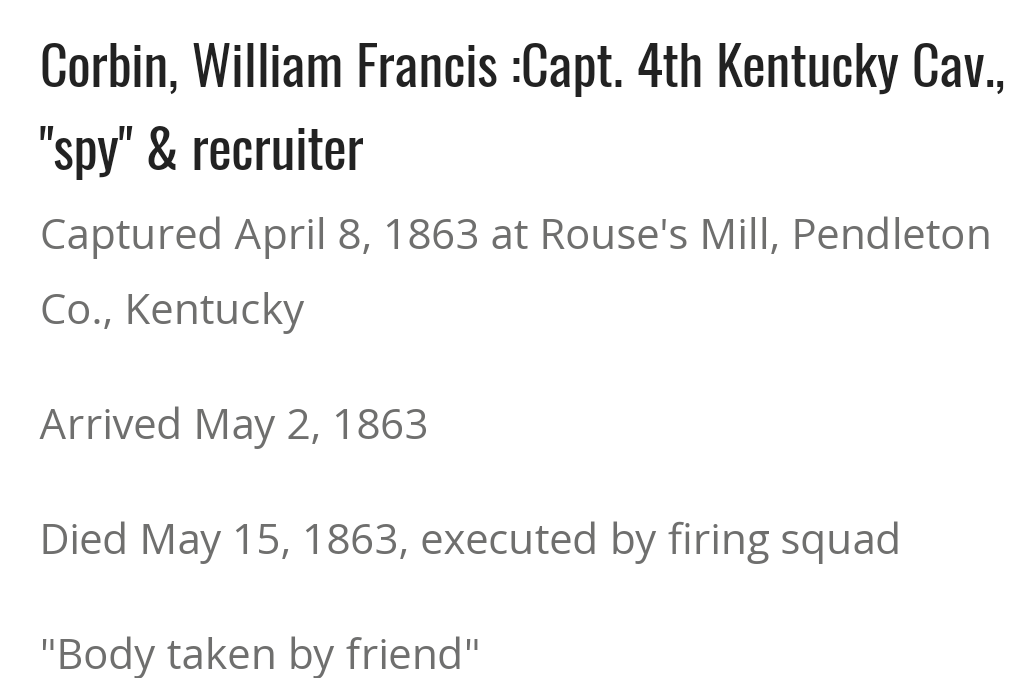Was born on a farm in Campbell County, Kentucky, near the village of Carthage, in the year 1834 (the son of John Corbin and Lucinda M Nelson).
~~~~~~~~~~~~~~~~~~~~~~~~~~~~~~~~~~~~~~~
Corbin was 30, an elder in the Christian Church at California. His arrest shocked the small community on the Ohio River. Corbin was among 60 young men form the California area who had joined the state home guard in 1860. According to John Caldwell Demoss, who organized the unit, the purpose was to defend Kentucky's neutrality from an invasion by either Union or Confederate armies.
Demoss, who in 1897 wrote a book about Corbin's wartime experiences, said that neutrality was soon broken as armies from both the North and the South invaded Kentucky. Corbin cast his lot with the Confederates. He was commissioned a captain and stationed during the winter of 1862-63 in Virginia. That following spring Corbin was back in Campbell County recruiting soldiers.
That activity landed Corbin at the home of Garrett Daniel near Rouse's Mill on the Campbell and Pendleton County line. Corbin was there on April 8 to meet with Jefferson McGraw another Southern recruiter. McGraw, however was followed to the Daniel home by a contingent of Union soldiers. The Union soldiers had been in the Gubser's Mill area of southern Campbell County looking for another Confederate recruiter, James Caldwell.
William Francis Corbin and Thomas Jefferson McGraw were bound securely and pushed into a wagon. To the sounds of a Union Army band, the wagon rumbled down the road of the prison installation. It was 1:20 pm, May 15, 1863, and Corbin and McGraw were more than 200 miles from their homes in Campbell County.
Corbin and McGraw were captured and tried in Cincinnati under a Union army order prohibiting Confederate recruitment in the area. Corbin and McGraw were found guilty despite the fact that the order prohibiting the recruitment wasn't issued until five days after their arrest. Corbin's sister, Melissa, went to Washington to ask President Abraham Lincoln to commute her brother's sentence. She pleaded that her brother was a good Christian man who should be treated like other prisoners of war.
Lincoln had granted a number such requests, but he rejected Miss Corbin's plea. It was now 1:40 pm May 15, 1863. McGraw and Corbin were unloaded from the wagon and marched onto the beach on Johnson's Island in Lake Erie, where they were being held. They were blindfolded and positioned in front of two large boxes.
Twelve Union soldiers were marched out. One of the soldiers fainted and had to be carried away. The order was given (by) and the shots rang out. McGraw and Corbin were knocked off their feet, landing in the coffins that had been placed behind them. McGraw gave one gasp and died. Corbin died silently. The bodies of both men were carried by steamboat back to California, where a memorial service held at the Corbin home.
Corbin was buried in the Corbin Family Cemetery, which is located on Washington Trace Road, near its intersection with California Cross-roads. McGraw was buried nearby in the Flagg Springs Baptist Church Cemetery on Kentucky 10. A monument, honoring McGraw was erected near his grave in 1914 by the Daughters of the Confederacy.
On the morning of his execution, Corbin had held a prayer service at his prison. He said life was just as sweet to him as to any man, but if he had to die, he was ready. Corbin said he had done nothing to be ashamed of "in the sight of God and man, and in the view of death which", awaited him. He believed he was right. And feeling this, he "nothing to fear in the future."
Was born on a farm in Campbell County, Kentucky, near the village of Carthage, in the year 1834 (the son of John Corbin and Lucinda M Nelson).
~~~~~~~~~~~~~~~~~~~~~~~~~~~~~~~~~~~~~~~
Corbin was 30, an elder in the Christian Church at California. His arrest shocked the small community on the Ohio River. Corbin was among 60 young men form the California area who had joined the state home guard in 1860. According to John Caldwell Demoss, who organized the unit, the purpose was to defend Kentucky's neutrality from an invasion by either Union or Confederate armies.
Demoss, who in 1897 wrote a book about Corbin's wartime experiences, said that neutrality was soon broken as armies from both the North and the South invaded Kentucky. Corbin cast his lot with the Confederates. He was commissioned a captain and stationed during the winter of 1862-63 in Virginia. That following spring Corbin was back in Campbell County recruiting soldiers.
That activity landed Corbin at the home of Garrett Daniel near Rouse's Mill on the Campbell and Pendleton County line. Corbin was there on April 8 to meet with Jefferson McGraw another Southern recruiter. McGraw, however was followed to the Daniel home by a contingent of Union soldiers. The Union soldiers had been in the Gubser's Mill area of southern Campbell County looking for another Confederate recruiter, James Caldwell.
William Francis Corbin and Thomas Jefferson McGraw were bound securely and pushed into a wagon. To the sounds of a Union Army band, the wagon rumbled down the road of the prison installation. It was 1:20 pm, May 15, 1863, and Corbin and McGraw were more than 200 miles from their homes in Campbell County.
Corbin and McGraw were captured and tried in Cincinnati under a Union army order prohibiting Confederate recruitment in the area. Corbin and McGraw were found guilty despite the fact that the order prohibiting the recruitment wasn't issued until five days after their arrest. Corbin's sister, Melissa, went to Washington to ask President Abraham Lincoln to commute her brother's sentence. She pleaded that her brother was a good Christian man who should be treated like other prisoners of war.
Lincoln had granted a number such requests, but he rejected Miss Corbin's plea. It was now 1:40 pm May 15, 1863. McGraw and Corbin were unloaded from the wagon and marched onto the beach on Johnson's Island in Lake Erie, where they were being held. They were blindfolded and positioned in front of two large boxes.
Twelve Union soldiers were marched out. One of the soldiers fainted and had to be carried away. The order was given (by) and the shots rang out. McGraw and Corbin were knocked off their feet, landing in the coffins that had been placed behind them. McGraw gave one gasp and died. Corbin died silently. The bodies of both men were carried by steamboat back to California, where a memorial service held at the Corbin home.
Corbin was buried in the Corbin Family Cemetery, which is located on Washington Trace Road, near its intersection with California Cross-roads. McGraw was buried nearby in the Flagg Springs Baptist Church Cemetery on Kentucky 10. A monument, honoring McGraw was erected near his grave in 1914 by the Daughters of the Confederacy.
On the morning of his execution, Corbin had held a prayer service at his prison. He said life was just as sweet to him as to any man, but if he had to die, he was ready. Corbin said he had done nothing to be ashamed of "in the sight of God and man, and in the view of death which", awaited him. He believed he was right. And feeling this, he "nothing to fear in the future."
Family Members
Advertisement
Explore more
Sponsored by Ancestry
Advertisement


